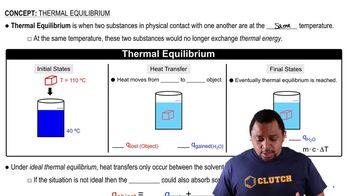Naphthalene (C10H8) is the main ingredient in traditional mothballs. Its normal melting point is 81 °C, its normal boiling point is 218 °C, and its triple point is 80 °C at 1000 Pa. Using the data, construct a phase diagram for naphthalene, labeling all the regions of your diagram.
Ch.11 - Liquids and Intermolecular Forces
Chapter 11, Problem 94
The vapor pressure of ethanol (C2H5OH) at 19 °C is 40.0 torr. A 1.00-g sample of ethanol is placed in a 2.00 L container at 19 °C. If the container is closed and the ethanol is allowed to reach equilibrium with its vapor, how many grams of liquid ethanol remain?
 Verified step by step guidance
Verified step by step guidance1
First, we need to convert the vapor pressure of ethanol from torr to atmospheres because the ideal gas law uses pressure in atmospheres. We can do this using the conversion factor 1 atm = 760 torr.
Next, we use the ideal gas law (PV=nRT) to calculate the number of moles of ethanol in the vapor phase. In this case, P is the pressure in atmospheres, V is the volume in liters, n is the number of moles, R is the ideal gas constant (0.0821 L·atm/K·mol), and T is the temperature in Kelvin.
Once we have the number of moles of ethanol in the vapor phase, we can convert this to grams using the molar mass of ethanol (46.07 g/mol). This will give us the mass of ethanol that has evaporated.
We then subtract the mass of evaporated ethanol from the initial mass of ethanol to find the mass of liquid ethanol that remains.
Remember that the ideal gas law assumes ideal behavior, so this calculation will be an approximation. Real gases do not always behave ideally, especially at high pressures and low temperatures.

Verified video answer for a similar problem:
This video solution was recommended by our tutors as helpful for the problem above.
Video duration:
5mWas this helpful?
Key Concepts
Here are the essential concepts you must grasp in order to answer the question correctly.
Vapor Pressure
Vapor pressure is the pressure exerted by a vapor in equilibrium with its liquid or solid phase at a given temperature. It indicates the tendency of a substance to evaporate; higher vapor pressure means a greater tendency to vaporize. For ethanol at 19 °C, the vapor pressure is 40.0 torr, which is crucial for determining how much liquid will remain when equilibrium is reached.
Recommended video:
Guided course

Raoult's Law and Vapor Pressure
Equilibrium
In chemistry, equilibrium refers to the state where the rates of the forward and reverse reactions are equal, resulting in constant concentrations of reactants and products. In this scenario, the equilibrium between liquid ethanol and its vapor will dictate how much ethanol remains in the liquid state once the system stabilizes in the closed container.
Recommended video:
Guided course

Thermal Equilibrium
Ideal Gas Law
The Ideal Gas Law (PV = nRT) relates the pressure, volume, temperature, and number of moles of a gas. In this problem, it can be used to calculate the number of moles of ethanol vapor present at equilibrium, which helps determine how much liquid ethanol remains after some has evaporated into the vapor phase.
Recommended video:
Guided course

Ideal Gas Law Formula
Related Practice
Textbook Question
Textbook Question
A particular liquid crystalline substance has the phase diagram shown in the figure. By analogy with the phase diagram for a nonliquid crystalline substance, identify the phase present in each area.
Textbook Question
In Table 11.3, we saw that the viscosity of a series of hydrocarbons increased with molecular weight, doubling from the six-carbon molecule to the ten-carbon molecule.
(a) The eight-carbon hydrocarbon, octane, has an isomer, isooctane. Would you predict that isooctane would have a larger or smaller viscosity than octane? Why?
Textbook Question
Using information in Appendices B and C, calculate the minimum grams of propane, C3H8(g), that must be combusted to provide the energy necessary to convert 5.50 kg of ice at -20 °C to liquid water at 75 °C
